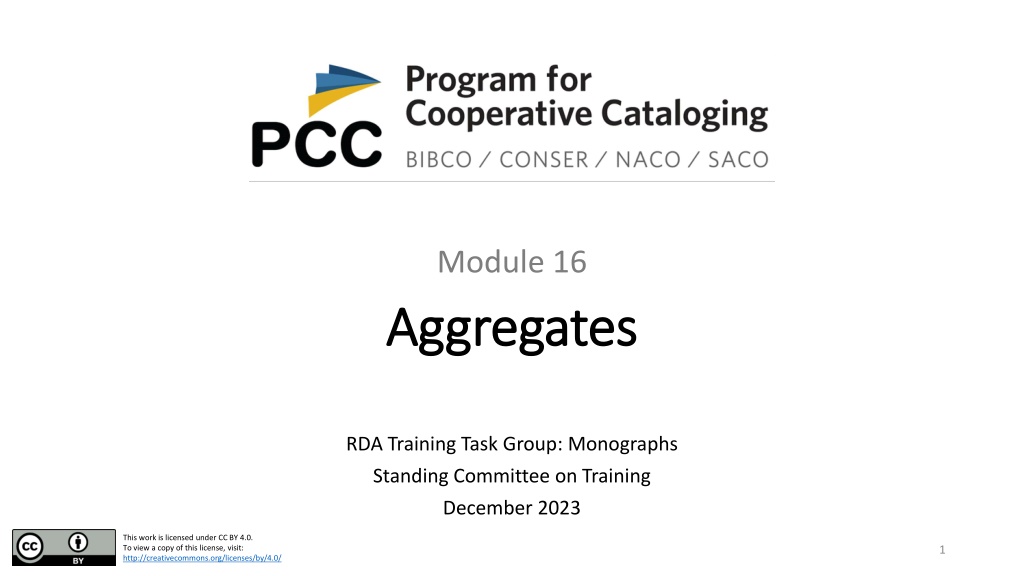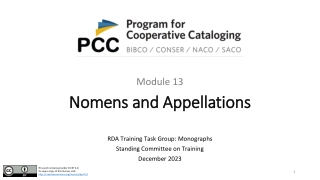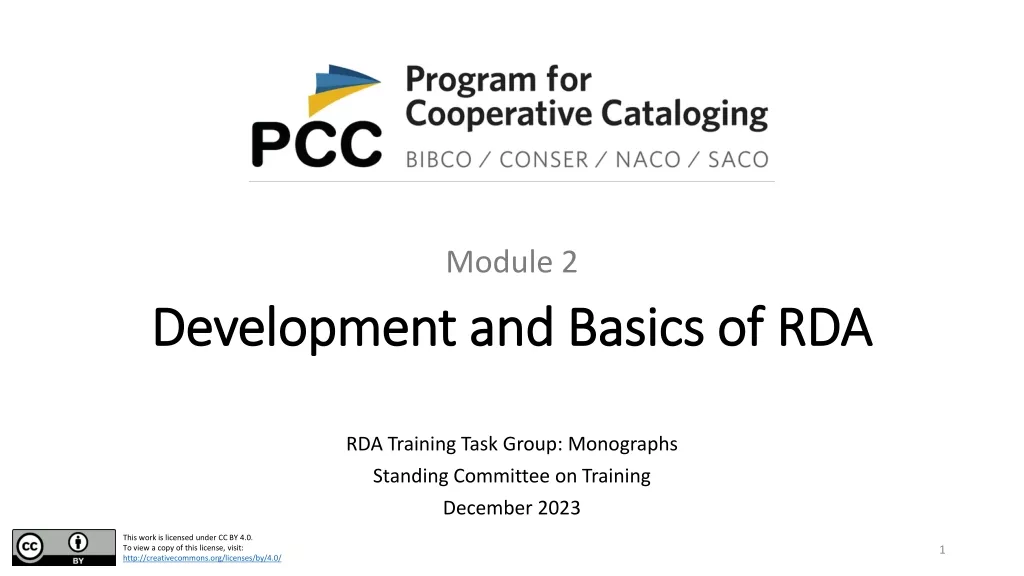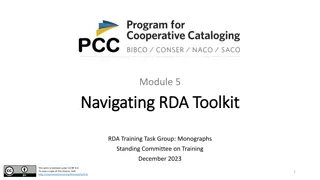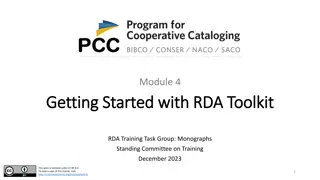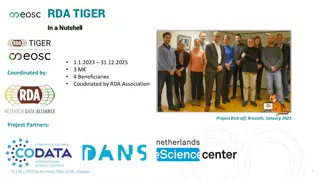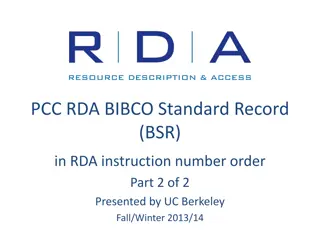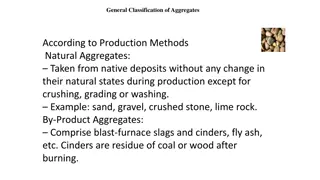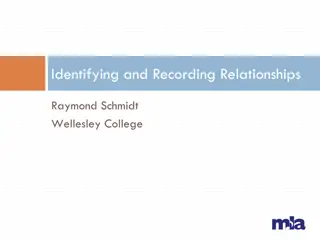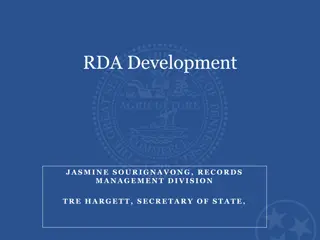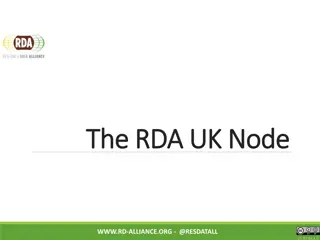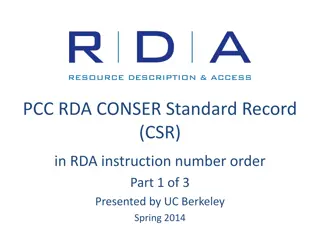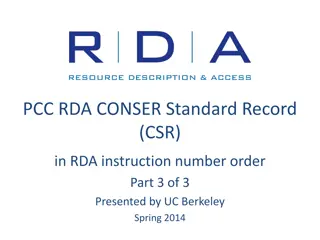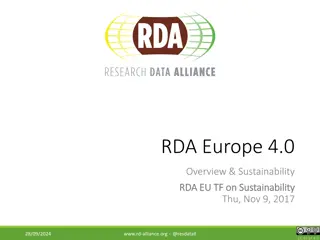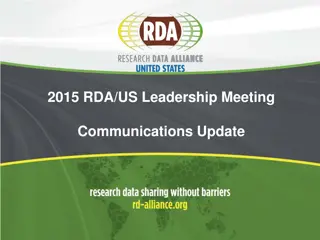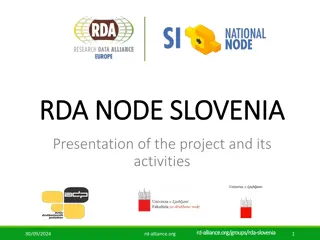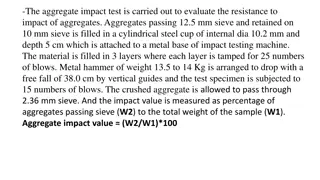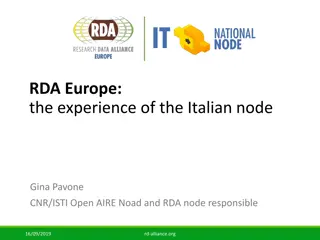Understanding Aggregates in RDA Training: A Comprehensive Overview
Explore the concept of aggregates in RDA training through this detailed module covering types of aggregates, LRM model, user-driven examples, and considerations in describing aggregates. Gain insights into collection, augmentation, and parallel aggregates with practical scenarios.
Download Presentation

Please find below an Image/Link to download the presentation.
The content on the website is provided AS IS for your information and personal use only. It may not be sold, licensed, or shared on other websites without obtaining consent from the author. Download presentation by click this link. If you encounter any issues during the download, it is possible that the publisher has removed the file from their server.
E N D
Presentation Transcript
Module 16 Aggregates Aggregates RDA Training Task Group: Monographs Standing Committee on Training December 2023 This work is licensed under CC BY 4.0. To view a copy of this license, visit: http://creativecommons.org/licenses/by/4.0/ 1
Learning Outcomes At the end of this module, you will be able to: Recognize what an aggregate is Identify the three types of aggregates in RDA Describe the LRM general model of aggregates Apply the general model to each type of aggregate 2
Outline Aggregates: what are they? User-driven examples Aggregates model in LRM and RDA Categories of aggregates in RDA Collection aggregate Augmentation aggregate Parallel aggregate Considerations in describing aggregates 3
Aggregates model Original RDA: whole-part relationships Official RDA: aggregates model from LRM Explains a variety of aggregates that might be sought by users Requires you to think about the overall plan for the aggregating work, how that plan is realized in an aggregating expression, and how that realization is ultimately manifested depending on the aggregate type Work element: extension plan Manifestation element: mode of issuance 5
User-driven examples of aggregates A first-year undergraduate student who is taking an expository and persuasive writing course searches for a specific anthology containing essays or prose excerpts from a range of sources, disciplines, and time periods. = Student searches for a collection aggregate 6
User-driven examples of aggregates High school student studying a Shakespeare play: Teacher assigns a specific critical edition, and requires students to read the editorial comments and notes contained in the edition = Teacher assigns an augmentation aggregate 7
User-driven examples of aggregates A bilingual Canadian government employee who prefers to use French wants to review discussion from an international workshop about radicalism hosted by the government: A report about the workshop was published by the Canadian government and is available through interlibrary loan. The employee obtains the report and discovers that it is in both French and English presented in t te- b che format. = Library patron borrows a parallel aggregate 8
to collect or gather into a mass or whole 9
LRM modelling of aggregates is based on a plan to bring together multiple expressions 10
RDA Toolkit Guidance: Aggregates Aggregating work = A plan to select and arrange two or more expressions and embody them in a single manifestation. Aggregating expression = An expression that realizes the plan of an aggregating work. Aggregate manifestation (i.e., an aggregate ) = A manifestation that embodies an aggregating expression, and one or more expressions that are aggregated. 11
RDA Toolkit Guidance: Aggregates An aggregate manifestation embodies multiple expressions. One of those expressions must be the aggregating expression (i.e., the realization of the plan). One plan (or aggregating work) is realized by one expression (i.e., the aggregating expression) You may choose to describe the individual expressions being aggregated. 12
PCC Metadata Guidance Document: Aggregates All aggregates embody two types of expressions. The 1sttype of expression is the aggregated expression. It is the expression of an aggregated work. These represent the content of an aggregate. An aggregate may contain more than one of this kind of expression. The 2ndtype of expression is the aggregating expression. It is the expression of the aggregating work. This is the plan for the aggregate. A plan includes what content was selected and how it is ordered in an aggregate. The plan is not the content itself. An aggregate contains one and only one of this kind of expression. 13
aggregate According to official RDA, a manifestation that embodies an aggregating expression and one or more expressions that are aggregated. 15
IFLA LRM general model for aggregates Riva, Pat, Patrick Le Boeuf, and Maja umer. Figure 5.7 General Model for Aggregates. In IFLA Library Reference Model: A Conceptual Model for Bibliographic Information, 94. The Hague: IFLA, 2017. 16
Interpreting the general model for aggregates Individual work 1 Individual work 2 17
Interpreting the general model for aggregates Individual work 1 Individual expression of work 1 Realization of work 1 Individual work 2 Individual expression of work 2 Realization of work 2 18
Interpreting the general model for aggregates Individual work 1 Individual expression of work 1 Realization of work 1 Individual work 2 Individual expression of work 2 Realization of work 2 19
Interpreting the general model for aggregates Individual work 1 Aggregating work The Plan Individual expression of work 1 Realization of work 1 Individual work 2 Individual expression of work 2 Realization of work 2 20
Interpreting the general model for aggregates Individual work 1 Aggregating work The Plan Individual expression of work 1 Realization of work 1 Individual work 2 Aggregating expression The realization of the Plan Individual expression of work 2 Realization of work 2 21
Interpreting the general model for aggregates Individual work 1 Aggregating work The Plan Individual expression of work 1 Realization of work 1 Aggregate manifestation The embodiment of the aggregating expression Individual work 2 Aggregating expression The realization of the Plan Individual expression of work 2 Realization of work 2 22
Categories of aggregates in RDA 1. Collection aggregate 2. Augmentation aggregate 3. Parallel aggregate 23
What is a collection aggregate? A manifestation that embodies expressions of two or more independent works . Examples: A compilation of short stories by a single author A collection of short stories by multiple authors An anthology of poems from a specific region or time period 24
Modeling collection aggregates A work by ... Aggregating work The plan to issue a primary source anthology, to be called The Broadview anthology of expository prose Aggregate manifestation Individual expression of that work by Zora Neale Hurston A work by Rebecca Solnit Aggregating expression The realization of that plan Individual expression of that work by Rebecca Solnit and others 25
What is an augmentation aggregate? A manifestation that embodies expressions of two or more works, where expressions of one or more works are supplemented by expressions of one or more other works . Each expression of an augmenting work supplements the expression of an augmented work without affecting the integrity or changing the content of either work. Examples: A monograph with a foreword, illustrations, bibliography, and index A music album on CD with a booklet containing song lyrics A DVD that embodies a motion picture with special features 26
augmenting work vs. augmented work augmenting work An aggregating work that adds expressions of one or more supplementary works to an expression of a central work . augmented work A work that is realized by an expression that is aggregated with one or more expressions of supplementary works . 27
Modeling augmentation aggregates Centralwork is Shakespeare s King Lear Aggregating work The plan to issue a Norton critical edition of King Lear containing notes, essays, etc. Aggregate manifestation Expression of central work, King Lear Critical notes by the editor Aggregating expression The realization of that plan Expression of critical notes by the editor 28
What is a parallel aggregate? A manifestation that embodies expressions of a single work . Examples: A report published by the Government of Canada containing text in both English and French A classic text published in the original language and a translation for comparative study 29
Modeling parallel aggregates Original English language work Aggregating work The plan to issue the original English text with the French translation Aggregate manifestation Original text in English Aggregating expression The realization of that plan Text translated into French 30
IFLA LRM general model for aggregates Cardinality rule: 1 aggregating expression realizes 1 aggregating work (rather than realizing the individual works) Riva, Pat, Patrick Le Boeuf, and Maja umer. Figure 5.7 General Model for Aggregates. In IFLA Library Reference Model: A Conceptual Model for Bibliographic Information, 94. The Hague: IFLA, 2017. 31
Implications for identifying aggregate types Three types: 1. Collection aggregate 2. Augmentation aggregate 3. Parallel aggregate Knowing what type of aggregate you have will influence how you provide access to the expressions or works aggregated 32
Considerations in describing an aggregate 1. aggregate manifestation + 2. its relationships to the expressions/works embodied RDA does not require recording all individual expressions/works embodied by an aggregate manifestation. If you record the aggregating expression/work, you do not need to record the individual expressions/works. 33
General aggregate model: the plan and content Individual work 1 Aggregating work The Plan Individual expression of work 1 Realization of work 1 Aggregate manifestation The embodiment of the aggregating expression Individual work 2 Aggregating expression The realization of the Plan Individual expression of work 2 Realization of work 2 34
Guidance in the RDA Toolkit Orientation Guidance Menu view Original Menu view 35
Locating the Metadata Guidance Document for Aggregates MGD main page: https://www.loc.gov/aba/rda/mgd/ Aggregates MGD: https://www.loc.gov/aba/rda/mgd/mg- aggregates.pdf 36
Summary An aggregate is a manifestation that embodies: 1. one aggregating expression and 2. one or more expressions that are aggregated. An aggregating expression realizes an aggregating work, which is a plan to select and arrange one or more expressions and embody them in an aggregate. 38
Summary There are 3 kinds of aggregates: 1. A collection aggregate embodies two or more expressions of two or more independent works. 2. An augmentation aggregate embodies two or more expressions of two or more works, where one work (i.e., the augmented work) is supplemented by one or more other works (i.e., the augmenting works). 3. A parallel aggregate embodies two or more expressions of a single work. 39
Acknowledgements The content of this module, particularly the visual models, draws on Elisa Sze s course material on diachronic works for the ALA eLearning course A Practical Approach to Cataloging with the New RDA held in August 2022. 40
